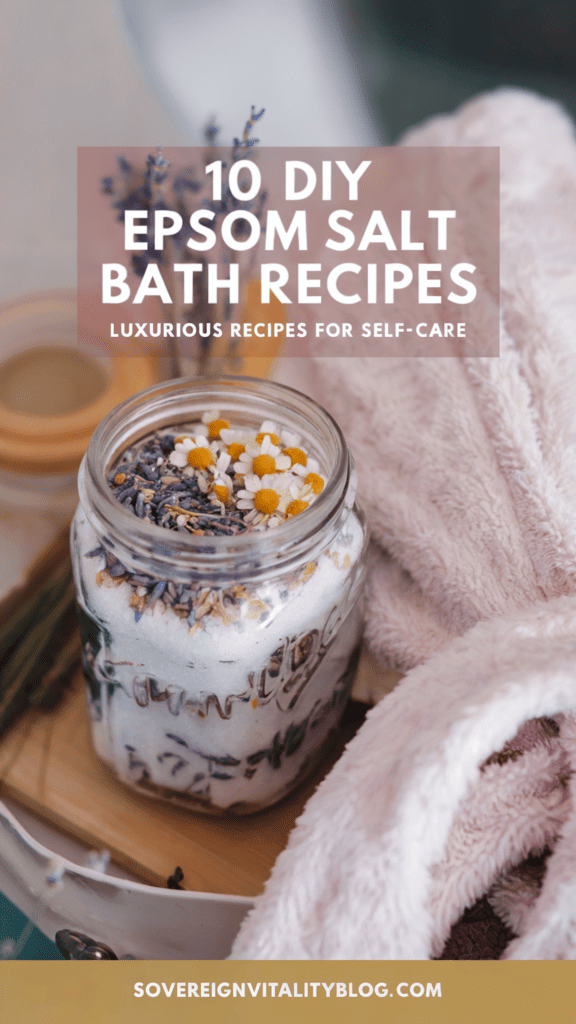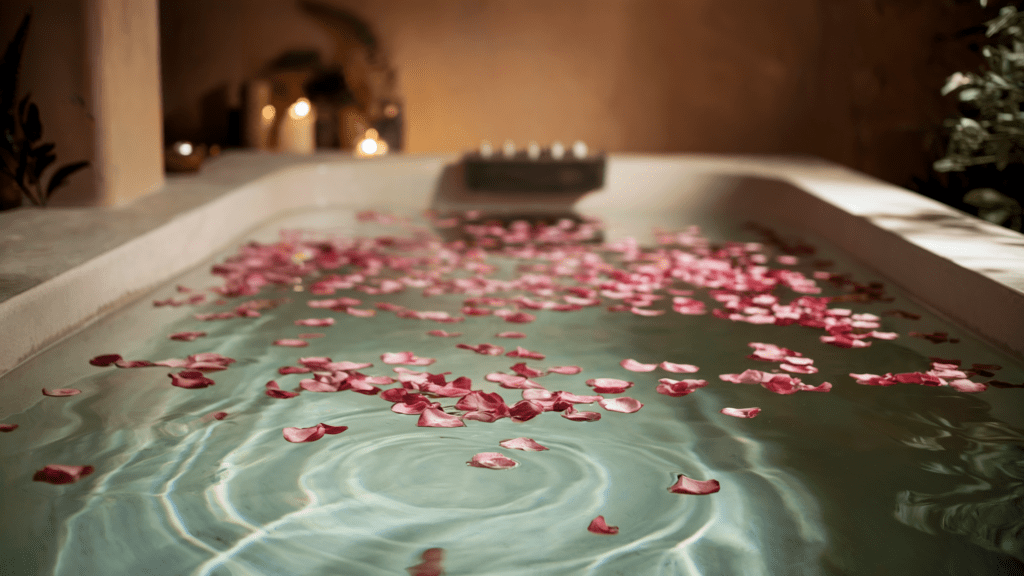This post may contain affiliate links, including those from Amazon Associates. If you make a purchase through these links, I may earn a commission at no additional cost to you. Learn more about our affiliate policy.
I’m at the point in my life where I swear by my Epsom salt baths as a necessary part of my self-care routine.
As someone who discovered the transformative power of Epsom salt baths during a particularly stressful period in my life, I can’t wait to share these incredible healing recipes with you.
Epsom salt baths should not be considered a luxury, but a regular self care routine that cleanses away stuck energy from your day. It’s a powerful part of a holistic lifestyle that can help you fall and stay asleep better, ease muscle pain, and support overall wellness, especially as we age.
Whether you’re a bath novice or a seasoned soaker, these 10 customized Epsom salt bath recipes will help bring your body into a calmer, more balanced state.

What are the health benefits of Epsom salt baths?
Muscle Recovery and Pain Relief: The magnesium in epsom salts helps reduce muscle tension and inflammation by promoting better blood flow to sore muscles.
Stress Reduction and Sleep: The combination of warm water and magnesium helps boost serotonin production while reducing stress hormones, promoting better sleep and relaxation.
Skin Health: Epsom salts provide gentle exfoliation and can help reduce skin inflammation while removing surface toxins.
Magnesium Absorption: Your body can absorb this essential mineral through your skin during a soak, supporting hundreds of vital bodily functions.
Reduces Inflammation: The unique combination of magnesium and sulfate helps decrease swelling throughout the body, particularly in joints and muscles.
Mental Clarity: Taking time for an epsom salt bath helps create a sense of mental refreshment while supporting overall mood enhancement.
Mixing and Storing Epsom Salt Soaks in Jars
My favorite way to store my Epsom salt bath soaks is in a jar because it’s so convenient for when I’m ready to relax, AND it looks beautiful on my bathroom shelf. Here’s how I do it:
- Start Mixing: Pour the Epsom salt into a large bowl, then stir in the essential oil blend until everything is evenly mixed.
- Layer It Up: For an extra special touch, layer the salt mixture with dried flowers, petals, or herbs in a jar depending on the recipe.
- Store and Enjoy: Once it’s ready, seal the glass jar and keep nearby in your bathroom.
Tip for Gifting: To turn it into a thoughtful self-care gift, tie a ribbon or piece of twine around the jar and attach a small tag with the recipe name and simple instructions like, “Add 1-2 cups to a warm bath and soak for 20 minutes.” It’s a heartfelt way to share relaxation and wellness with someone you care about!
How to Enjoy Your Epsom Salt Bath
- Fill Your Tub: Start by running warm water – just hot enough to dissolve the salts but still comfortable to soak in.
- Add the Soak: Sprinkle 1-2 cups of your Epsom salt mixture into the water as it fills, stirring gently with your hand to help it dissolve evenly.
- Set the Mood: Light a candle, play calming music, or dim the lights to create a relaxing atmosphere.
- Soak and Unwind: Step in and soak for 20-30 minutes, allowing the salts and essential oils to work their magic on your body and mind.
Take a deep breath, let go of the day’s stress, and enjoy the soothing benefits of your bath—you’ve earned it!
10 Therapeutic Epsom Salt Bath Recipes
1. Classic Relaxation Blend

This blend has become my go-to for a peaceful yet uplifting soak. The bright, citrusy scent of bergamot combined with the warm, grounding aroma of frankincense creates the perfect balance for melting away stress while clearing your mind. It’s like a mini spa retreat in your bathtub. It’s like a warm hug after a long day.
- 1 cup Epsom salt
- 4 drops bergamot essential oil
- 3 drops frankincense essential oil
- Optional: 1 tablespoon dried calendula flowers for a soothing and decorative touch
2. Deep Sleep Soak

This is my secret weapon for falling and staying asleep naturally. I discovered this combination during a particularly stressful week, and it’s become an essential part of my evening wind-down routine.
- 1 cup Epsom salt
- 3 drops lavender essential oil
- 2 drops chamomile essential oil
- Optional: 1 tablespoon dried lavender flowers
3. Post-Workout Recovery Soak
After discovering how much this blend helped my sore muscles, it became my favorite post-yoga ritual. The invigorating combination of peppermint and eucalyptus creates a cooling sensation that seems to reach deep into tired muscles. It’s like having a spa massage in your own bathtub!
- 1 cup Epsom salt
- 5 drops peppermint essential oil
- 3 drops eucalyptus essential oil
- Optional: 1 tablespoon dried rosemary
4. Skin-Soothing Blend

The dry winter air left my skin feeling stressed and irritated until I created this gentle recipe. The combination of colloidal oatmeal and calendula has been a game-changer for my sensitive skin. This is my favorite blend for those times when my skin needs extra TLC.
- 1 cup Epsom salt
- 1/4 cup colloidal oatmeal
- 2 drops calendula essential oil
- Optional: 1 tablespoon dried chamomile flowers
5. Immune Support Bath

This blend is my go-to during cold and flu season. I love how the eucalyptus and tea tree oils work together to create a refreshing, spa-like experience that feels like a boost to my body’s natural defenses. It’s perfect for when I feel like I need a little extra support to stay well.
- 1 cup Epsom salt
- 3 drops eucalyptus essential oil
- 2 drops tea tree essential oil
- Optional: 1 tablespoon dried thyme
6. Detox Support Soak

Whenever I feel sluggish or in need of a reset, this blend helps me feel cleansed and rejuvenated. The warming ginger combined with the uplifting scent of lemon is so invigorating – it feels like pressing the reset button on my body.
- 1 cup Epsom salt
- 3 drops ginger essential oil
- 2 drops lemon essential oil
- Optional: Sliced fresh ginger
7. Hormonal Balance Blend

This blend has become an essential part of my monthly self-care ritual. The gentle floral scents of rose and geranium create such a soothing environment, helping me feel balanced and nurtured during those emotional ups and downs.
- 1 cup Epsom salt
- 3 drops rose essential oil
- 2 drops geranium essential oil
- Optional: Dried rose petals
8. Morning Energizing Soak
This is the blend I turn to when I need a little extra energy to kickstart my day. Maybe I didn’t sleep well the night before or just feeling in a funk. The refreshing rosemary and lemon scents are like a wake-up call for my senses, leaving me feeling clear-headed and motivated.
- 1 cup Epsom salt
- 3 drops rosemary essential oil
- 2 drops lemon essential oil
- Optional: Fresh lemon slices
Helps wake up your senses and boost morning motivation.
9. Headache Relief Recipe
This is my favorite remedy for those days when tension starts to build. The cooling peppermint combined with calming lavender creates such a soothing experience, and keeping a cool compress nearby makes it even more effective.
- 1 cup Epsom salt
- 3 drops peppermint essential oil
- 2 drops lavender essential oil
- Optional: Cool compress nearby
10. Romantic Rose Petal Soak

This is the ultimate indulgence for a romantic evening or a solo self-love ritual. The combination of rose and ylang-ylang is so luxurious and relaxing, and adding dried rose petals feels like stepping into a dream.
- 1 cup Epsom salt
- 3 drops rose essential oil
- 2 drops ylang-ylang essential oil
- Optional: Dried rose petals
Conclusion
These Epsom salt bath recipes have transformed my self-care routine, and I hope they’ll do the same for you. Remember, the key is to listen to your body and experiment with what works best for you. Don’t be afraid to adjust the recipes, mix and match essential oils, and create your own unique blends.
Start with one recipe that speaks to you, and gradually explore the others. Your body and mind will thank you for this simple yet powerful form of self-care.

Frequently Asked Questions About Epsom Salt Baths
How do I take an Epsom salt bath correctly?
To take an Epsom salt bath, add 1–2 cups of Epsom salt to a standard-sized bathtub filled with warm water. The water temperature should be warm, between 92°F and 100°F, to ensure comfort and relaxation. Soak for 15–20 minutes to allow the magnesium to absorb through your skin. Evening baths are ideal for promoting relaxation and improving sleep quality.
What are the specific health benefits of Epsom salt baths?
Epsom salt baths provide several health benefits, including relief from muscle pain and tension, stress reduction, and improved sleep. They can also soothe irritated or dry skin and gently exfoliate dead cells. Additionally, magnesium absorption through the skin may help with muscle function, stress relief, and overall relaxation.
Are there any risks or side effects of Epsom salt baths?
While Epsom salt baths are generally safe, they can cause skin irritation in people with sensitive skin. Those with health conditions like kidney problems or diabetes, or those taking medications, should consult a doctor before frequent use. Overuse can lead to dehydration or, in rare cases, magnesium toxicity.
How often should I take Epsom salt baths for optimal results?
For general relaxation, taking an Epsom salt bath 2–3 times a week is usually sufficient. If you are using them for muscle recovery or skin care, adjust the frequency based on your needs. Signs of overuse include dizziness, skin irritation, or unusual fatigue, in which case you should reduce frequency or the amount of Epsom salt used.
What is the history and composition of Epsom salt?
Epsom salt was first discovered in natural springs in the town of Epsom, England, during the 17th century. It is made of magnesium sulfate, a naturally occurring mineral compound known for its therapeutic properties.
What is the difference between Epsom salt and other bath salts?
Epsom salt is purely magnesium sulfate and is usually unscented, making it a simple and therapeutic choice. Other bath salts often contain fragrances, oils, or sea minerals and are more tailored for aromatherapy or cosmetic purposes.
Are there other uses for Epsom salt?
Epsom salt is commonly used in agriculture and gardening to improve soil quality and promote plant growth, particularly for roses, tomatoes, and peppers. It can also be customized with essential oils, dried herbs, or flowers to create personalized blends for relaxation or therapeutic purposes.



